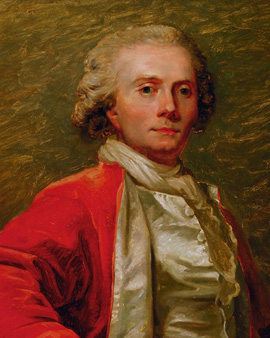


The splendor and elegance of the 18th century, captured in its finest nuances and facets, symbolizes the life and work of French artist Jean-Laurent Mosnier. Born in Paris in 1743, Mosnier became a defining figure of the European artistic panorama and a virtuoso court painter to King Louis XVI and Queen Marie-Antoinette. His stunning paintings and art prints give lasting, tangible expression to historical figures and moments. As a student at the Académie de Saint-Luc in Paris, Mosnier perfected his skills as a miniature painter, an art form that challenges the artist's patience, precision, and attention to detail. His remarkable ability to capture the finest details caught the attention of the royal family and led to his appointment as court painter to Queen Marie-Antoinette in 1776. Mosnier's work during this period captures the dazzling world of French court life, with each of his paintings and fine art prints telling a story and giving the viewer a glimpse into the life of the royal family.
With the outbreak of the French Revolution in 1790, Mosnier's life and career were turned upside down. He fled to London and found himself in a completely new cultural and artistic environment. In order to satisfy the tastes and preferences of the English public, he adapted his style and created artworks that blended seamlessly into the English art scene. This ability to adapt to different cultural contexts was demonstrated again when he moved after stays in Hamburg and eventually St. Petersburg, where he became a member of the Academy in 1802 and later received tenure as a professor. There he painted numerous portraits of members of the Russian nobility and imperial family, including a remarkable portrait of Tsarina Elizabeth Alexeyevna, wife of Alexander I. Jean-Laurent Mosnier's work is a testament to his adaptability and keen eye for detail and precision. Trained as a miniaturist, he was a master at capturing the finest details in his large-scale portraits, giving each of his works an impressive depth and vividness. Even today, his paintings and art prints immerse viewers in the fascinating world of the 18th century, a testament to his remarkable talent and relentless pursuit of artistic perfection.

The splendor and elegance of the 18th century, captured in its finest nuances and facets, symbolizes the life and work of French artist Jean-Laurent Mosnier. Born in Paris in 1743, Mosnier became a defining figure of the European artistic panorama and a virtuoso court painter to King Louis XVI and Queen Marie-Antoinette. His stunning paintings and art prints give lasting, tangible expression to historical figures and moments. As a student at the Académie de Saint-Luc in Paris, Mosnier perfected his skills as a miniature painter, an art form that challenges the artist's patience, precision, and attention to detail. His remarkable ability to capture the finest details caught the attention of the royal family and led to his appointment as court painter to Queen Marie-Antoinette in 1776. Mosnier's work during this period captures the dazzling world of French court life, with each of his paintings and fine art prints telling a story and giving the viewer a glimpse into the life of the royal family.
With the outbreak of the French Revolution in 1790, Mosnier's life and career were turned upside down. He fled to London and found himself in a completely new cultural and artistic environment. In order to satisfy the tastes and preferences of the English public, he adapted his style and created artworks that blended seamlessly into the English art scene. This ability to adapt to different cultural contexts was demonstrated again when he moved after stays in Hamburg and eventually St. Petersburg, where he became a member of the Academy in 1802 and later received tenure as a professor. There he painted numerous portraits of members of the Russian nobility and imperial family, including a remarkable portrait of Tsarina Elizabeth Alexeyevna, wife of Alexander I. Jean-Laurent Mosnier's work is a testament to his adaptability and keen eye for detail and precision. Trained as a miniaturist, he was a master at capturing the finest details in his large-scale portraits, giving each of his works an impressive depth and vividness. Even today, his paintings and art prints immerse viewers in the fascinating world of the 18th century, a testament to his remarkable talent and relentless pursuit of artistic perfection.
Page 1 / 1






